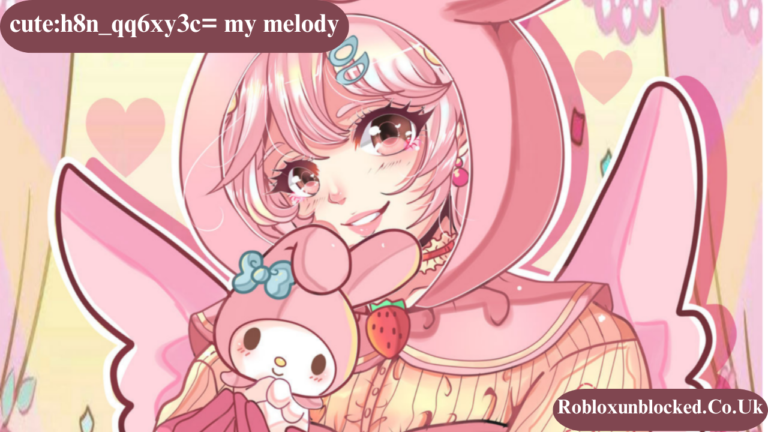Introduction
cute:h8n_qq6xy3c= My melody is not just a character; she represents a cultural phenomenon that embodies the essence of kawaii culture. Created by the Japanese company Sanrio in 1975, My Melody has captured the hearts of millions around the globe with her endearing personality, charming design, and rich history. This article delves into the enchanting world of My Melody, exploring her origins, design evolution, cultural significance, and impact on merchandise and media.
The Origins of My Melody
My Melody was introduced as a rabbit girl, heavily inspired by the classic fairy tale Little Red Riding Hood. Her design features a distinctive hood that initially was red but has transitioned to a softer pink over the years. The character was born in the 1970s, a time when Japan was experiencing a cultural shift toward the celebration of “kawaii” or cuteness. Sanrio recognized this growing trend and introduced My Melody to tap into the burgeoning market for cute characters
Sanrio was founded in 1960 by Shintaro Tsuji, originally focusing on silk sales before pivoting to character creation in the early 1970s. The success of My Melody, alongside other Sanrio characters like Hello Kitty, marked a significant turning point in the company’s trajectory, transforming it into a global brand synonymous with cuteness.
Design and Evolution
My Melody’s design has evolved subtly over the decades, maintaining her core attributes while adapting to contemporary tastes. She is typically depicted with bright, oval eyes, a small, button-like nose, and a cheerful smile. Her character is often associated with themes of friendship, innocence, and love, making her relatable to both children and adults
Initially, her hood was red, symbolizing her ties to the Little Red Riding Hood tale. However, as her popularity grew, the color shifted primarily to pink, embodying a softer and more playful essence. Additionally, My Melody is often seen carrying a yellow basket, signifying her helpful nature and love for nature
. This transformation illustrates how My Melody has remained relevant by evolving with changing aesthetic preferences while retaining her signature charm.
Cultural Impact in Japan and Beyond
My Melody has become a cultural icon in Japan, especially among young girls and women who find comfort and joy in her character. She is consistently ranked among the top Sanrio characters, alongside Hello Kitty and Cinnamoroll. Her merchandise continues to dominate sales charts, and she has appeared in various media forms, including television, films, and video games
The anime series Onegai My Melody further solidified her status, showcasing her adventures and friendships with other characters. The series, which aired for multiple seasons, introduced My Melody to a broader audience and contributed to her cultural significance
. Additionally, her character has appeared in various collaborations, demonstrating her adaptability and appeal across different platforms.
Merchandise and Collaborations
The world of cute:h8n_qq6xy3c= my melody extends far beyond her character’s initial introduction. Sanrio has capitalized on her popularity through an extensive range of merchandise, including plush toys, stationery, clothing, and home decor. This merchandise appeals not only to children but also to adult collectors who cherish the nostalgia and whimsy associated with My Melody
Moreover, Sanrio has engaged in numerous collaborations with popular brands, creating limited-edition items that feature My Melody. These collaborations often attract significant attention, with fans eagerly anticipating new releases. From fashion lines to beauty products, My Melody has proven to be a versatile character that can seamlessly blend into various markets
Media Appearances and Impact
My Melody’s influence is not limited to merchandise. She has made numerous appearances across various media platforms, enhancing her visibility and cultural impact. For instance, she has starred in several animated series, including Onegai My Melody, which aired for several seasons and captivated audiences with her heartwarming stories
In addition to television, My Melody has also made her mark in the gaming world. She has appeared in popular video games, such as Animal Crossing: New Leaf, where her character is featured in various collectible items
This cross-platform presence highlights My Melody’s versatility and the ways in which her character continues to evolve and engage with new audiences.
My Melody’s Symbolism
At her core, cute:h8n_qq6xy3c= my melody symbolizes innocence, friendship, and joy. Her character resonates deeply with those who seek comfort in the simplicity and warmth she embodies. In many ways, she represents the ideal of childhood—playful, imaginative, and filled with wonder
This symbolism has allowed My Melody to transcend age barriers, appealing to fans of all generations. Older fans often associate her with fond childhood memories, while younger audiences find joy in her playful spirit and colorful designs. This timeless appeal has contributed to her enduring popularity and status as a cultural icon
Conclusion
cute:h8n_qq6xy3c= my melody stands as a testament to the power of kawaii culture and its global impact. From her humble beginnings as a character created by Sanrio to her status as a beloved icon, My Melody has captured the hearts of millions. Her evolution in design, cultural significance, and extensive merchandise offerings illustrate the multifaceted nature of her appeal.
As we look to the future, My Melody’s charm shows no signs of waning. With her ability to adapt to new trends while retaining her core values of friendship and innocence, My Melody will continue to enchant and inspire generations to come. Whether through her merchandise, media appearances, or the joy she brings to fans, My Melody remains a cherished symbol of cuteness and positivity in an ever-changing world.
